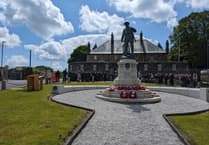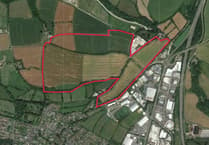FOLLOWING the front page story (Cornish Times, May 18) on the Merrymeet and Pengover Green Residents’ Association’s reaction to the Diocese of Truro’s plan to close and then sell off St Mary’s Church in Merrymeet (pictured), the residents’ association has provided further evidence for their view that it was largely the people of the local area who funded the building.
The Residents’ Association wants to safeguard the church for community use as it is the main community hub and only building in the village where meetings and gatherings can be held. The main church of the parish cluster at Menheniot is three miles away.
Residents’ Association secretary Lynette Luck says they have had a brief reply from the office of Bishop of Truro, the Rt Rev Philip Mounstephen, to the letter they wrote to him concerning the closure and sale of the church building, thanking them for “sharing your thoughts and concerns about the closing of the church and related matters” and that the letter had been passed on to The Ven Kelly Betteridge in her capacity as Archdeacon to respond to them.
Lynette has found original documents from 1905 giving an account of the then new St Mary’s Church building entitled: ‘Mission Church for Merrymeet. Dedication by the Archdeacon of Bodmin. Description of the New Building’. She says these documents support local residents’ view that the greater part of the funding for the new building was raised by people of the area and that only a small amount was contributed by the Church of England – something that the Bishop’s Office said was ‘inaccurate’.
Lynette said: “At the end of the day the CofE only put £15 in if this amount was not raised from the miscellaneous entertainment the following week.”
The 1905 account of the service of dedication talks of the need for a church for the neighbourhood’s then 400 residents.
It says: ‘For many years past the Vicar of Menheniot (Canon C E Hammond) has had this matter under consideration, and a dozen years ago he began to collect subscriptions towards a small Church, but owing to a lack of support the scheme fell through. With the arrival, however, of a new assistant curate (Rev F Thomas), considerable vigour was infused into Church life…. A preliminary meeting of the residents in the Merrymeet district was held on October 13th, 1903, with the result that a general meeting of parishioners was held at Menheniot three weeks later, at which the Vicar announced he had received contributions and promises amounting to £250.
‘At the outcome of that gathering it was decided to erect an iron church, the following gentlemen forming the Building Committee. The Vicar, curate and churchwardens, and Messrs F J Arthur, E Batten, T Bennett, W Ford, W Mutton, W E Upfield and J E Wyatt.
‘Eventually it was deemed expedient to erect a building of stone instead of iron at a cost of £700. The corner stone of the new building was laid on May 11th last by Miss J B Jago of Coldrennick. Subscriptions have since come in satisfactorily, and as a result of a bazaar held last summer and other efforts, Canon Hammond was on Wednesday able to make the gratifying announcement that the debt on the Church would not be a troublesome one, as no less than £680 had already been subscribed to meet the total cost of about £750.’
These same sums – together with the resounding applause given by the ‘close upon a hundred ladies and gentlemen’ attending – are confirmed in an account of a public luncheon to celebrate the dedication of the church also found by Lynette.
This part of the account adds that Major-General Jago-Trelawny had given ‘a very handsome subscription, in addition to the stone with which the walls were constructed’; that ‘presents for beautifying the interior had come from Miss Jago and other members of the family’; that Mr W N C Marshall, of Treworgey, ‘had given the Bulland Down stone for the door and window dressings’; and the Vicar of St Cleer (Rev T S Lanyon) ‘had assisted with gifts of furniture’.
The account of the luncheon then adds: ‘That meant in any case their debt would not be very excessive after the results of the day’s proceedings [i.e further on the spot donations from the guests] had been added. The Church Building Society had promised £25. Therefore, their debt was not likely to prove a troublesome one – (hear, hear)’.
It also says that a number of ladies had contributed items for a ‘sale of work’, presumably artwork and craft items of the kind typically produced by Edwardian women, and that, after the choral evensong and tea and entertainment were over, ‘Mr F M Sobey, in a humorous manner, disposed of by auction the articles remaining from the sale of work….
‘The proceedings of the day from collections, sale of work, tea etc, amounted to £30’ – a larger sum that the Church Building Society had promised to contribute!’
The Cornish Times has contacted the Diocese of Truro for further comment.





Comments
This article has no comments yet. Be the first to leave a comment.